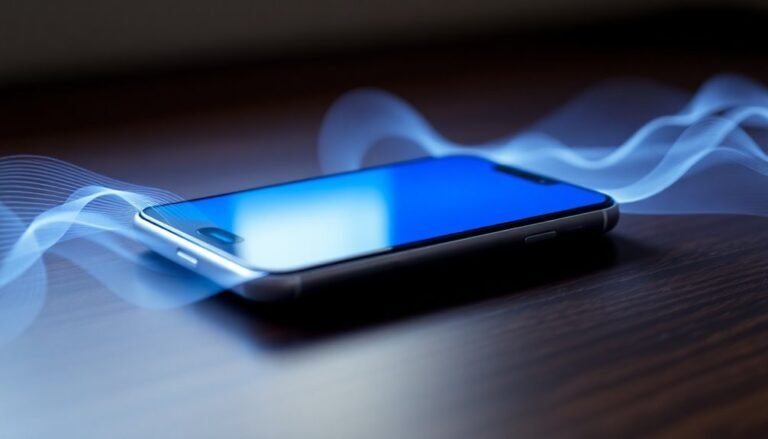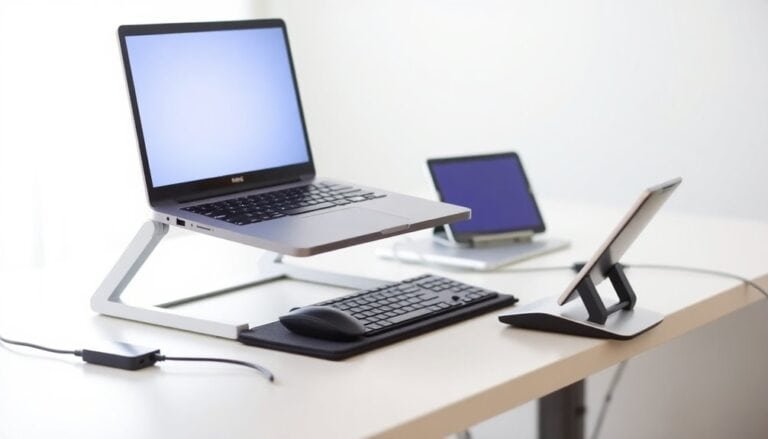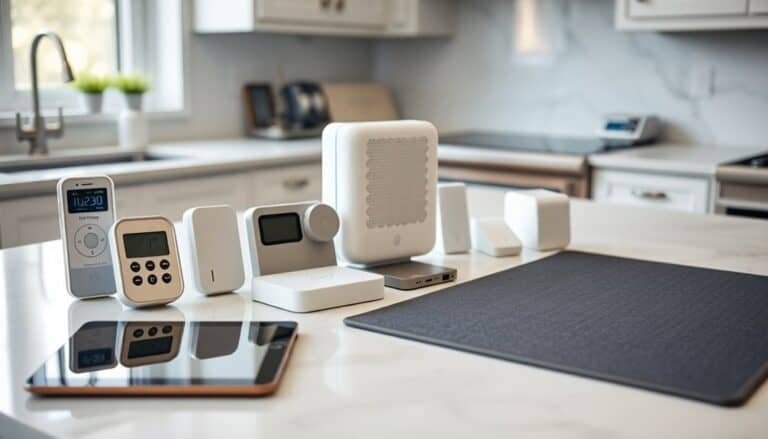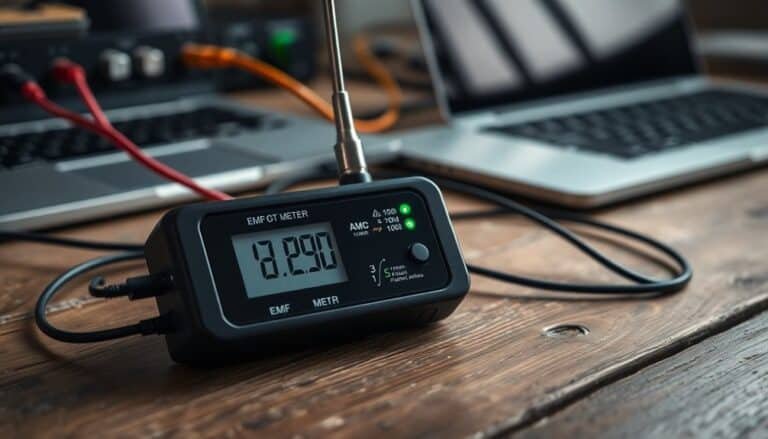Baby Monitors: Safety Tips to Reduce EMF
Position baby monitors at least 3 feet from cribs and opt for low-EMF models with zero-emission modes that activate only during sound detection. Consider wired monitors to eliminate RF radiation and use EMF shielding materials to block radiation from outlets and devices.
Select models with automatic shut-off features to reduce continuous transmission. For more effective monitoring solutions, seek additional information.
Disclaimer: As an affiliate, I may collect a share of sales from the links on this page.
Understanding EMF Exposure Risks for Children

While children grow and develop, their bodies are particularly vulnerable to electromagnetic radiation (EMF). Children’s brains, due to their developmental stage, can absorb EMF more easily, increasing susceptibility to potential health risks. Research links high EMF exposure to a twofold increase in childhood leukemia at levels above 0.4 μT. Additionally, prolonged exposure may impact cellular growth, potentially contributing to conditions like ADHD and autism. Environmental factors, such as proximity to underground transmission lines and device usage, further elevate exposure levels. Consequently, monitoring EMF in children’s environments is essential to mitigate these risks and promote better health outcomes. In Korea, recommendations suggest maintaining distance from electrical appliances to reduce exposure. Developing babies are particularly vulnerable due to rapid cell division, making awareness of EMF exposure crucial.
Distancing Baby Monitors From Cribs
To minimize risks associated with electromagnetic field (EMF) exposure and guarantee safety, positioning baby monitors at a proper distance from cribs is critical.
Place monitors at least 3 feet (1 meter) away to reduce EMF exposure and prevent cord-related hazards. Keep cords out of reach to avoid accidental strangulation. Aim for a height that provides a clear view of the crib, yet isn’t directly above the baby. Additionally, make certain monitors are inaccessible to toddlers, preventing any tampering. A wide viewing angle ensures full visibility of the baby’s area, enhancing monitoring effectiveness. Prolonged exposure to EMF radiation can potentially lead to negative effects on health, making proper placement essential for your child’s well-being.
These measures greatly improve safety while allowing effective monitoring, balancing practicality with environmental considerations in your baby’s space.
User Education on EMF Guidelines

How can you guarantee the safety of your baby when using electronic devices? First, educate yourself about EMFs—energy fields generated by devices like baby monitors.
Limit exposure by measuring EMF levels using an EMF meter, ensuring they’re low, especially in the nursery. Always consider low-EMF options, such as Bebcare’s Digital Safe Radio technology, which reduces emissions considerably. Snuza monitors offer important features that prioritize baby safety while monitoring. Additionally, consider using home filters to block or absorb EMF radiation from outlets and routers.
Place monitors strategically, away from cribs. Turn off devices at night to minimize exposure during sleep.
For safety, stay informed on new guidelines and research regarding EMF risks, particularly concerning baby health and development. Being proactive can considerably enhance your baby’s safety.
Exploring Wired Baby Monitor Options
Wired baby monitors offer a reliable alternative for parents looking to guarantee a safer monitoring solution for their infants. These monitors eliminate RF radiation, providing a healthier environment.
They use EMF-free cables, like Cat 8, to minimize electromagnetic interference and enhance privacy by protecting against hacking. With cameras and microphones, they provide audio and visual monitoring.
Their long cables, often 50 ft, allow flexible placement, while easy installation guarantees user-friendliness. Wired systems don’t require Wi-Fi, connecting directly to viewing devices.
Consider features like resolution and safety certifications when choosing, as these factors contribute considerably to your child’s safety and monitor effectiveness.
Low-EMF Alternatives for Safer Monitoring

Low-EMF baby monitors provide an alternative that prioritizes your baby’s safety by limiting exposure to electromagnetic radiation.
These monitors come with specific features that guarantee lower emissions, such as:
- Zero-Emission Modes: Transmissions activate only with sound detection.
- Digital vs. Analog: Digital models typically emit less radiation.
- Sensor Technology: Advanced sensors minimize continuous transmission.
- No WiFi Option: Non-WiFi devices greatly reduce EMF exposure.
The Importance of Turning Off Devices
When you turn off baby monitors when they’re not needed, you effectively reduce your child’s constant exposure to electromagnetic fields (EMFs).
This practice decreases overall EMF radiation, markedly benefiting your child’s health. By minimizing operational time, you enhance energy efficiency and reduce risks of overheating or malfunctions.
Many safety features become less effective when devices run unnecessarily for prolonged periods. Regularly switching off devices also simplifies maintenance, helping to maintain performance and extend lifespan.
Additionally, it creates a safer sleep environment by minimizing EMF exposure and reducing disturbances, enhancing sleep quality for both you and your child.
Using EMF Shielding Materials
To enhance your baby’s safety, incorporating EMF shielding materials is a practical approach.
These materials effectively reduce harmful emissions from baby monitors without impacting their functionality.
When selecting your shielding options, consider the following features:
- EMF Blocking Technology: Use high-quality radiation-blocking fabric.
- Material Safety: Verify the materials are infant-friendly.
- Design and Installation: Opt for user-friendly designs that blend with nursery décor.
- Compatibility with Monitors: Confirm the shield works with your specific baby monitor model.
Implementing these strategies will guarantee a safer environment for your baby, minimizing EMF exposure while maintaining essential monitoring capabilities.
Benefits of Automatic Shut-Off Features
Automatic shut-off features greatly enhance the functionality of baby monitors by conserving energy, reducing EMF exposure, and extending battery life.
These features automatically turn off the device when it’s not in use, saving power and lowering electricity bills. By minimizing continuous EMF exposure, they address safety concerns for both infants and parents.
Furthermore, they enhance security by decreasing the risk of unauthorized access. Automatic shut-off promotes convenience, allowing busy parents to focus on their child without distractions from unnecessary alerts.
Ultimately, these features contribute to a more efficient, safe, and user-friendly monitoring experience.
Raising Public Awareness About EMF
Raising awareness about electromagnetic fields (EMF) is essential in today’s technologically advanced environment. Many people express health concerns about EMF exposure from common sources. However, scientific research hasn’t confirmed health risks from low-level EMF.
To enhance understanding of EMF, consider the following:
- EMF comes from diverse sources, like power lines, microwaves, and mobile phones.
- Public transport and shopping malls often expose individuals to higher RF EMF levels.
- The WHO’s International EMF Project focuses on ongoing research and education.
- Media coverage frequently raises awareness but may exaggerate risks.
Educating the public can mitigate fears and clarify misconceptions surrounding EMF.
Advocating for Stricter Regulatory Standards
While current regulations exist, they often fall short of adequately protecting vulnerable populations, such as infants. Many countries enforce basic standards, yet these mainly restrict short-term EMF exposure.
Current guidelines don’t adequately address long-term effects or cumulative exposure from multiple devices. Vulnerable groups, like children, may experience different health effects.
With scientific knowledge lagging, older regulations remain in place, ignoring necessary precautions. Stricter standards should mandate independent testing and low-EMF certifications for baby products.
Advocating for these measures not only guarantees infant safety but promotes essential transparency in the market, ultimately benefiting families collectively.
Frequently Asked Questions
What Are the Symptoms of EMF Exposure in Children?
If your child experiences headaches, fatigue, sleep disturbances, or neurological symptoms like dizziness and mood swings, these could be potential symptoms of EMF exposure, though scientific proof linking them remains inconclusive. Stay informed and cautious.
How Far Should a Baby Monitor Be From the Baby’s Head?
You should place the baby monitor at least three feet away from your baby’s head to guarantee safety while maintaining sound quality. Adjust the distance as needed to provide a clear view without risks.
Do EMF Levels Vary by Baby Monitor Brand?
Absolutely, EMF levels vary by baby monitor brand. Imagine picking a cozy blanket; some monitors emit more radiation, while others stay snugly low. You’ll find lower EMF options by exploring brands like Bebcare or LeReve.
Can I Use My Baby Monitor During Naps?
Yes, you can use your baby monitor during naps, but it’s crucial to position it safely. Make certain cords are out of reach, check your baby frequently, and prioritize safe sleep practices above all.
Are There Any Long-Term Studies on Baby Monitor EMF Effects?
You’ll find that thorough long-term studies specifically investigating baby monitor EMF effects are lacking. Current research focuses more on immediate impacts, leaving many questions unanswered about potential long-term consequences for infants’ health and development.
Conclusion
To ensure your child’s safety, focus on reducing EMF exposure from baby monitors. Maintain a distance, opt for wired models, and explore low-EMF alternatives.
Shielding materials can offer extra protection, and automatic shut-off features help conserve energy and limit exposure. As awareness increases, advocating for stricter regulations becomes crucial.
Like a gardener nurturing delicate blooms, create a safer environment for your child while navigating modern parenting technology.






